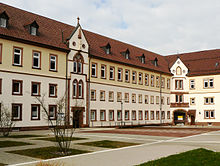Heiligenbronn Monastery
The Heiligenbronn Monastery in today's Heiligenbronn district of the city of Schramberg is a convent of the Franciscan Sisters in the Black Forest , which stands on the site of a healing spring and pilgrimage church that has been known since the 14th century.
A hamlet and Lichtenau Castle had probably existed in Heiligenbronn since the middle of the 13th century . The latter was abandoned by the lords of the castle after 1353 - they settled in the Berneck Valley, while the hamlet existed until after 1444. There was also the Lichtenau church, a branch of the parish church in Dunningen . According to legend, a healing spring was built at the current location of the monastery in the 14th century. In 1385 a Franciscan bought a piece of land on which the spring was located and in 1442 a wayside shrine was erected. Soon the spring became a place of pilgrimage ; the pilgrims built a small Lady Chapel at the source in the middle of the 15th century. Later a residential and a pilgrim house was built, which was donated by Elisabeth von Rechberg in 1463/64 ; then Franciscans built a hospice that belonged to the Franciscan monastery in Villingen . A larger church was soon built.
After two plague epidemics and decreasing income from pilgrimages, the Franciscans withdrew to Villingen around 1532 . In 1547/51 Rochus Merz von Staffelfelden acquired the place of pilgrimage together with the Schramberg rulership . The miraculous image was put up again, Heiligenbronn became a place of the Counter Reformation . In the course of the Thirty Years' War the image was brought to Oberndorf am Neckar , but returned to Heiligenbronn in 1637. However, it was not until 1700 that the number of pilgrims increased again and a new chapel was built. The rule was now in the possession of the barons of Bissingen-Nippenburg. In 1850 the place received its own spiritual direction. In mid-1855, David Fuchs, the first vicar, came to Heiligenbronn and stayed until his death in 1885. In 1856, he began building a house near the spring, which was to be used as an orphanage under the direction of the Sisters of the Third Order of the Franciscan Sisters. In the spring of 1857, the first five candidates came who were introduced to monastic life by a sister from Dillingen an der Donau . The dressing up took place on September 9, 1857 , and the first four orphans were admitted a week later. Soon deaf and blind children were taken in for care. In the following years the number of children increased steadily, in 1864 there were 19 sisters and 79 children in Heiligenbronn, in 1871 there were already 32 sisters, 16 candidates, 68 orphans, 42 deaf-mute and 10 blind, so a total of 168 people. In 1900 400 people lived in the monastery (compared to 209 inhabitants in the village), in 1935 the community had the highest number of 323 professed sisters. In the following years, numerous subsidiary houses were formed, in 1957 there were subsidiary houses in:
- Waldachtal - Heiligenbronn (near Horb)
- Baindt (Ravensburg district)
- Birnau near Überlingen
- Freudenstadt
- Neuhausen / Fildern
- Roseck Castle near Tübingen
- Sulgen near Schramberg
- European court in Stuttgart
- Riedlingen
- Rottweil
- Ahldorf (Freudenstadt district)
- Börstingen (Tübingen district)
- Salzstetten (Freudenstadt district)
- Lützenhardt (Freudenstadt district)
- Hypocrites near Schwäbisch Gmünd
- Balgheim (Tuttlingen district)
As the demands on care increased steadily, but the number of sisters decreased, the St. Franziskus Heiligenbronn Foundation was set up in 1991 , which is to continue the tasks of the monastery as a provider of assistance for the disabled.
literature
- The Rottweil district. ed. vd Landesarchivdirektion Baden-Württemberg. Volume 2, Ostfildern 2003, pp. 204f.
- U. Windhab: Heiligenbronn - place of consolation and help. In: Schramberg. Dominion - Markflecken - industrial city. ed. v. Schramberg Museum and History Association and the large district town of Schramberg. Schramberg 2004, pp. 319-326.
- Württemberg monastery book. Ostfildern 2003, ISBN 3-7995-0220-3 .
- U. Windhab: Pilgrimage and Welfare. The story of Heiligenbronn and its monastery. Ostfildern 2007, ISBN 978-3-7966-1357-9 .
Web links
- Heiligenbronn Monastery
- Franciscan monastery Heiligenbronn in the database of monasteries in Baden-Württemberg of the Baden-Württemberg State Archives
Coordinates: 48 ° 15 ′ 29 ″ N , 8 ° 26 ′ 52 ″ E



